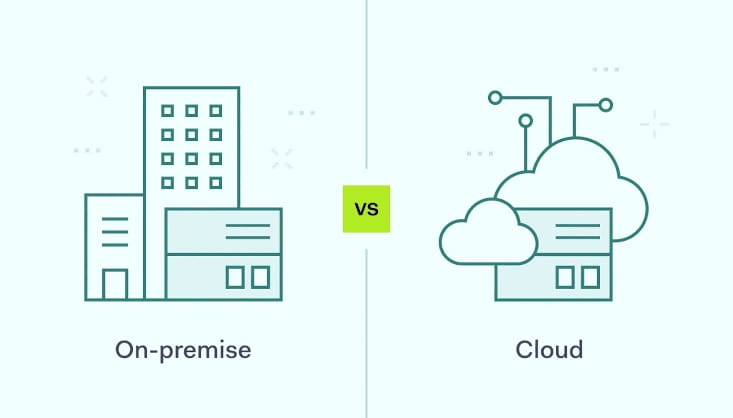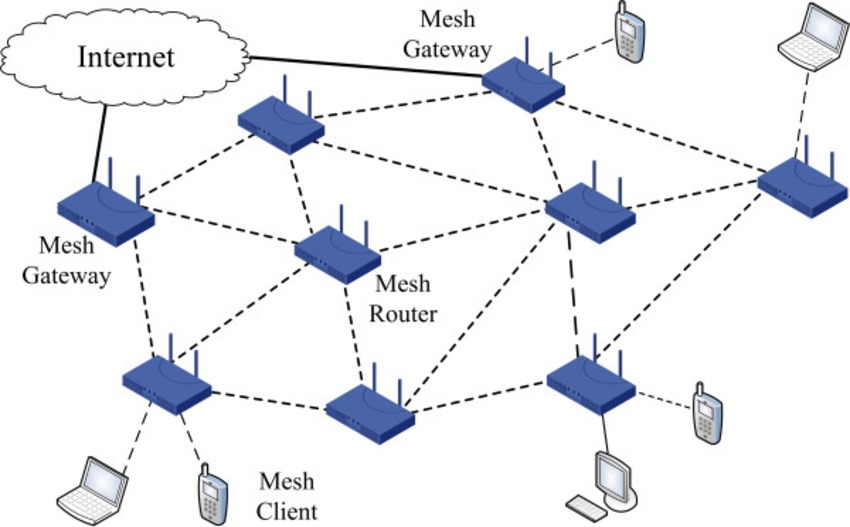
Cloud Infrastructure vs. On-Premises: Pros and Cons for Enterprises
Enterprises often face a critical choice between cloud and on-premises infrastructure. Cloud solutions offer scalability, flexibility, and cost-efficiency, especially suited for dynamic workloads and remote work. On the other hand, on-premises setups provide better control, security, and compliance, making them ideal for regulated industries. Each model has its pros and cons regarding cost, maintenance, data security, and accessibility. As technology evolves, many businesses are adopting a hybri
✨ Raghav Jain

Introduction
In today's rapidly evolving digital landscape, businesses are constantly faced with critical infrastructure decisions that shape their performance, scalability, and operational efficiency. One of the most significant decisions enterprises must make is choosing between cloud infrastructure and on-premises infrastructure.
The choice between the cloud and on-premises solutions is not just a technical one—it impacts cost, security, compliance, scalability, and innovation. While cloud computing has surged in popularity due to its flexibility and scalability, on-premises systems still hold strong appeal for organizations that require greater control over data and infrastructure. Cloud infrastructure and on-premises solutions represent two fundamentally different approaches to managing an enterprise's IT needs, each presenting a unique set of advantages and disadvantages that can significantly impact an organization's operational efficiency, cost structure, security posture, and overall agility. Cloud infrastructure, characterized by its reliance on shared pools of configurable computing resources accessible over a network, offers enterprises a compelling alternative to the traditional on-premises model, where IT infrastructure is owned, managed, and operated within the organization's physical premises. The core appeal of cloud infrastructure lies in its inherent scalability and flexibility, allowing businesses to rapidly provision and de-provision resources, such as computing power, storage, and networking capabilities, on demand and typically on a pay-as-you-go basis. This elasticity eliminates the need for significant upfront capital expenditure on hardware and the associated costs of maintenance, upgrades, and power consumption, transforming IT spending from a capital expenditure (CapEx) to an operational expenditure (OpEx) model. Furthermore, cloud providers often offer a wide array of managed services, including databases, analytics, artificial intelligence, and machine learning, which can accelerate innovation and reduce the operational burden on internal IT teams, enabling them to focus on core business objectives rather than routine infrastructure management. The global reach and robust infrastructure of major cloud providers also offer enhanced disaster recovery and business continuity capabilities, with geographically distributed data centers ensuring high availability and resilience against localized failures. However, the adoption of cloud infrastructure is not without its challenges. Concerns regarding data security and compliance are paramount, as sensitive enterprise data is entrusted to a third-party provider, necessitating rigorous due diligence and adherence to industry-specific regulations. Vendor lock-in, where migrating data and applications between different cloud providers becomes complex and costly, is another potential drawback that enterprises must carefully consider. Moreover, while the pay-as-you-go model can be cost-effective for variable workloads, consistently high utilization can sometimes lead to higher long-term costs compared to a fully depreciated on-premises infrastructure. Performance can also be a concern for latency-sensitive applications, as data may need to travel across the internet to reach the cloud provider's servers. Finally, enterprises relinquish a degree of direct control over their infrastructure in the cloud model, relying on the provider's service level agreements and operational expertise.
In contrast, on-premises infrastructure provides enterprises with complete control over their IT environment, allowing them to customize hardware and software configurations to meet specific performance and security requirements. This direct control can be particularly advantageous for organizations with stringent regulatory compliance needs or those handling highly sensitive data that they prefer to keep within their physical boundaries. On-premises deployments often provide predictable costs over the long term, especially after the initial capital investment in hardware has been made and depreciated. For applications with low latency requirements or those that need to interact closely with local hardware, on-premises infrastructure can offer superior performance. Furthermore, enterprises retain full responsibility for data security and governance, which can be seen as a benefit by organizations that prefer to manage their own security protocols and access controls. However, the on-premises model also comes with significant drawbacks. The initial capital expenditure for hardware, software licenses, and the establishment of a dedicated data center can be substantial, creating a high barrier to entry. Scalability is also a major challenge, as expanding capacity requires significant lead times for procurement, installation, and configuration of new hardware, making it difficult to respond quickly to fluctuating business demands. The ongoing costs of maintenance, upgrades, power consumption, cooling, and the need for a dedicated IT staff to manage the infrastructure can also be considerable. Moreover, on-premises infrastructure can lack the inherent redundancy and disaster recovery capabilities of a well-designed cloud environment, requiring additional investment and effort to implement comparable levels of resilience. The pace of innovation can also be slower with on-premises solutions, as enterprises are responsible for evaluating, procuring, and implementing new technologies themselves, rather than readily accessing a broad range of managed services offered by cloud providers. Ultimately, the choice between cloud infrastructure and on-premises solutions is not a binary one but rather a strategic decision that depends heavily on an enterprise's specific needs, priorities, risk tolerance, and long-term business objectives. Many organizations are increasingly adopting a hybrid cloud approach, combining on-premises infrastructure with cloud services to leverage the benefits of both models, optimizing workloads based on factors such as cost, performance, security, and compliance. This hybrid strategy allows enterprises to retain control over sensitive data and critical applications while benefiting from the scalability and flexibility of the cloud for other workloads. Furthermore, the emergence of multi-cloud strategies, where organizations utilize services from multiple cloud providers, is gaining traction as a way to mitigate vendor lock-in and enhance resilience. In conclusion, the decision between cloud and on-premises infrastructure requires a thorough evaluation of an enterprise's unique requirements and a careful consideration of the trade-offs associated with each approach. While cloud infrastructure offers compelling advantages in terms of scalability, cost-effectiveness, and access to advanced services, on-premises solutions provide greater control and can be preferable for certain security-sensitive or latency-dependent workloads. The optimal strategy for many enterprises often involves a hybrid or multi-cloud approach that strategically blends these models to achieve the best balance of agility, cost efficiency, security, and control.
Understanding Cloud Infrastructure
Cloud infrastructure refers to the use of remote servers hosted on the internet to store, manage, and process data, rather than relying on local servers or physical hardware. Cloud service providers (CSPs) like Amazon Web Services (AWS), Microsoft Azure, and Google Cloud Platform (GCP) offer a wide range of services, including computing power, storage, networking, databases, AI tools, and more.
Cloud models typically include:
- Public Cloud: Resources are shared among multiple tenants (e.g., AWS, Azure).
- Private Cloud: Dedicated resources hosted on-premises or by third parties.
- Hybrid Cloud: A mix of cloud and on-premises environments working together.
The core benefit of cloud infrastructure is its on-demand access, pay-as-you-go model, and rapid scalability.
Understanding On-Premises Infrastructure
On-premises infrastructure, often called "on-prem," involves hosting servers, storage, and networking hardware within an organization’s physical location. All software and data are maintained and managed by the internal IT team.
On-prem solutions are traditionally preferred by industries with stringent data privacy regulations or specific hardware requirements. This infrastructure provides full control, customization, and security under the company’s direct supervision.
While it requires a higher upfront investment and ongoing maintenance, it offers predictability and compliance for organizations that need a tighter grip on their infrastructure.
Pros of Cloud Infrastructure
1. Scalability and Flexibility
Cloud services allow enterprises to scale resources up or down based on demand. Whether it’s handling seasonal spikes or business growth, organizations can adjust infrastructure without major hardware investments.
2. Lower Upfront Costs
Cloud infrastructure significantly reduces capital expenditures (CapEx). Businesses pay only for what they use—making it a cost-effective solution, especially for startups and small-to-medium enterprises (SMEs).
3. Quick Deployment
Setting up cloud services is typically faster than deploying on-prem systems. With pre-configured environments and automation tools, businesses can launch applications or services within minutes.
4. Accessibility and Collaboration
Cloud infrastructure allows users to access data and applications from anywhere, enabling remote work, global collaboration, and improved productivity.
5. Disaster Recovery and Backup
Most cloud providers offer robust disaster recovery, automatic data backups, and failover mechanisms, reducing the risk of data loss.
6. Security and Compliance Tools
Leading cloud providers invest heavily in cybersecurity, offering tools like encryption, intrusion detection, and compliance certifications (e.g., HIPAA, GDPR, ISO).
Cons of Cloud Infrastructure
1. Ongoing Operational Costs
While initial costs are low, long-term cloud usage can lead to unexpected expenses if not monitored properly—especially with large data transfers or always-on services.
2. Limited Control
Organizations must rely on their CSPs for uptime, security patches, and infrastructure maintenance. This lack of physical control can be a concern for highly regulated industries.
3. Vendor Lock-In
Migrating between cloud providers can be complex and expensive. Proprietary tools and configurations often lead to vendor dependency.
4. Data Privacy and Compliance Challenges
Despite robust security, some organizations hesitate to store sensitive data off-premises due to legal and compliance risks, particularly in healthcare, finance, and government sectors.
Pros of On-Premises Infrastructure
1. Full Control Over Data and Hardware
With on-premises solutions, businesses maintain complete ownership and control over their infrastructure. They can customize hardware, software, and security policies to fit their exact needs.
2. Data Sovereignty and Compliance
On-prem systems are ideal for industries that must adhere to strict data residency and privacy laws, as data does not leave the organization's premises.
3. Predictable Long-Term Costs
Once infrastructure is purchased, there are no ongoing subscription fees. This can result in lower costs over time compared to variable cloud billing.
4. High Performance for Specific Applications
Certain high-performance applications or latency-sensitive workloads perform better on local servers, where network bottlenecks are minimized.
5. Customization and Integration
Organizations can deeply customize their systems and integrate with legacy tools and in-house software without compatibility concerns.
Cons of On-Premises Infrastructure
1. High Initial Capital Expenditure
Setting up on-prem infrastructure requires substantial investment in hardware, software licenses, and facility upgrades, making it less accessible for small businesses.
2. Maintenance and Staffing Requirements
Ongoing maintenance, hardware upgrades, and system monitoring fall entirely on internal IT teams, requiring dedicated staff and resources.
3. Scalability Limitations
Unlike cloud environments, scaling on-premises infrastructure involves purchasing and installing new hardware—an expensive and time-consuming process.
4. Limited Remote Access
Unless configured with additional remote access tools, on-prem systems do not naturally support remote work or global accessibility.
5. Disaster Recovery Complexity
Disaster recovery requires separate offsite backups and failover systems, which are costly and complex to implement effectively.
Cloud vs. On-Premises: A Comparative Table
FeatureCloud InfrastructureOn-Premises InfrastructureInitial CostsLow (Opex-based)High (Capex-based)ScalabilityHighly scalableLimited and hardware-dependentControlShared with providerFull internal controlDeployment TimeFastSlowerMaintenanceHandled by providerRequires internal IT staffRemote AccessibilityHighLimited unless configuredCompliance & Data SovereigntyCan be challengingEasier to enforceCustomizationLimited to provider’s offeringsFully customizableDisaster RecoveryOften built-inMust be configured
Use Cases: When to Choose What?
Ideal Scenarios for Cloud Infrastructure
- Startups or SMEs with limited capital
- Companies with fluctuating or unpredictable workloads
- Remote or globally distributed teams
- Projects requiring rapid deployment and innovation
Ideal Scenarios for On-Premises Infrastructure
- Businesses in heavily regulated sectors (e.g., finance, healthcare)
- Enterprises with existing IT infrastructure and expertise
- Applications that demand low-latency performance
- Organizations with long-term, stable workloads
The Rise of Hybrid and Multi-Cloud Strategies
Rather than choosing strictly between cloud and on-premises, many enterprises are adopting hybrid infrastructure strategies. This approach combines on-premises systems with public and/or private cloud services, providing:
- Greater flexibility
- Improved risk management
- Optimized cost-performance balance
Multi-cloud environments, where organizations use services from multiple cloud providers, are also gaining traction to avoid vendor lock-in and improve availability.
Tools like VMware vSphere, Red Hat OpenShift, and Azure Arc help enterprises manage and orchestrate resources across hybrid and multi-cloud setups effectively.
Security Considerations for Both Models
Regardless of infrastructure type, security is paramount. Here’s how both compare:
- Cloud: Shared responsibility model; providers secure the infrastructure, while customers secure data, access, and workloads.
- On-Premises: Full responsibility lies with the organization, from physical security to cybersecurity.
Enterprises must adopt strong identity and access management (IAM), encryption, network segmentation, and threat detection practices, regardless of the model.
Conclusion
The decision between cloud infrastructure and on-premises solutions is not one-size-fits-all. Each offers distinct benefits and limitations, and the right choice depends on a company’s strategic priorities, budget, regulatory environment, and technical capabilities.
Cloud infrastructure excels in scalability, flexibility, and accessibility, making it ideal for businesses that prioritize agility and innovation. On-premises solutions offer control, security, and compliance, which is critical for regulated industries and legacy systems.
In many cases, the most effective approach lies in hybrid or multi-cloud models that blend the best of both worlds. By carefully assessing their unique needs, enterprises can make informed infrastructure decisions that drive long-term success in a digitally connected world.
Q&A Section
Q1: What is the difference between cloud infrastructure and on-premises infrastructure?
Ans: Cloud infrastructure is hosted and managed over the internet by third-party providers, while on-premises infrastructure is physically located and maintained within an organization’s premises.
Q2: What are the main advantages of cloud infrastructure for enterprises?
Ans: Cloud infrastructure offers scalability, cost-efficiency, remote access, and reduced need for hardware maintenance, making it ideal for growing or distributed teams.
Q3: What are the primary benefits of on-premises infrastructure?
Ans: On-premises infrastructure provides full control, enhanced data security, and customization according to organizational needs, especially for businesses with strict compliance requirements.
Q4: How does cost vary between cloud and on-premises infrastructure?
Ans: Cloud infrastructure follows a pay-as-you-go model with lower upfront costs, while on-premises infrastructure involves high initial investment but can be more cost-effective in the long term for large-scale, stable workloads.
Q5: Which infrastructure offers better scalability and flexibility?
Ans: Cloud infrastructure offers better scalability and flexibility, allowing enterprises to quickly increase or decrease resources based on demand without needing physical upgrades.
Q6: How do cloud and on-premises models handle data security?
Ans: Cloud providers invest heavily in security measures, but data is stored offsite, raising privacy concerns. On-premises infrastructure offers tighter control over data, but security depends on internal resources and expertise.
Q7: What are the maintenance responsibilities in both models?
Ans: In cloud infrastructure, maintenance is handled by the service provider. In on-premises setups, the enterprise is responsible for managing, updating, and repairing all hardware and software.
Q8: How do cloud and on-premises infrastructures support remote work?
Ans: Cloud infrastructure supports remote work seamlessly by allowing access from anywhere. On-premises infrastructure requires VPNs or additional tools to enable secure remote access.
Q9: Which model is better for compliance-heavy industries?
Ans: On-premises infrastructure is often preferred in compliance-heavy industries like finance or healthcare due to greater control over data handling and regulatory adherence.
Q10: Can enterprises use a hybrid approach combining both models?
Ans: Yes, many enterprises adopt a hybrid approach, leveraging the scalability of cloud and the control of on-premises to meet both performance and compliance needs.
Similar Articles
Find more relatable content in similar Articles

Why Mesh Networks Might Replac..
Mesh networks are transforming.. Read More

Foldable Screens in 2025: Are ..
Foldable screens have finally .. Read More

How Blockchain Is Reinventing ..
Blockchain is transforming cyb.. Read More

Wearable Health Sensors: The D..
Wearable health sensors are re.. Read More
Explore Other Categories
Explore many different categories of articles ranging from Gadgets to Security
Smart Devices, Gear & Innovations
Discover in-depth reviews, hands-on experiences, and expert insights on the newest gadgets—from smartphones to smartwatches, headphones, wearables, and everything in between. Stay ahead with the latest in tech gear
Apps That Power Your World
Explore essential mobile and desktop applications across all platforms. From productivity boosters to creative tools, we cover updates, recommendations, and how-tos to make your digital life easier and more efficient.
Tomorrow's Technology, Today's Insights
Dive into the world of emerging technologies, AI breakthroughs, space tech, robotics, and innovations shaping the future. Stay informed on what's next in the evolution of science and technology.
Protecting You in a Digital Age
Learn how to secure your data, protect your privacy, and understand the latest in online threats. We break down complex cybersecurity topics into practical advice for everyday users and professionals alike.
© 2025 Copyrights by rTechnology. All Rights Reserved.